Festoon
This article includes a list of general references, but it lacks sufficient corresponding inline citations. (February 2014) |

A festoon (from
foliage or fruit bound together and suspended by ribbons.[2] The motif is sometimes known as a swag when depicting fabric or linen.[3][4]
In modern English the verb forms, especially "festooned with", are often used very loosely or figuratively to mean having any type of fancy decoration or covering.
Origins and design
Its origin is probably due to the representation in stone of the garlands of natural flowers, etc., which were hung up over an entrance doorway on fête days, or suspended around an altar.[2][4]
The design was largely employed both by the
Romans and formed the principal decoration of altars, friezes and panels.[4] The ends of the ribbons are sometimes formed into bows or twisted curves; when in addition a group of foliage or flowers is suspended, it is called a drop or margent.[2]
The
Tivoli
.
Gallery
-
Detail of an Ancient Greek mosaic floor, Pergamon Museum, Berlin, Germany, unknown architect, 2nd century BC
-
Roman trompe-l'œil wall painting from a villa, with festoons and bucrania, c.50-40 BC, fresco, Metropolitan Museum of Art, New York
-
Highly decorated Roman sarcophagus with festoons, c.125-130 AD, marble, Louvre
-
Roman festoon, c.70 BC, mosaic, Casa di Nettuno e Anfitrite, Herculaneum Archaeological Park, Ercolano, Italy[5]
-
Festoons on Roman cremation urns, 2nd century AD, marble, Musée d'archéologie méditerranéenne, Marseille, France
-
Byzantine festoon at the top of a relief of Empress Ariadne, c.500, ivory, National Bargello Museum, Florence, Italy[6]
-
Festoon, masks and rosettes made of shells, by Jan van Kessel the Elder, 17th century, color on copper, Fondation Custodia, Paris
-
Garland of Flowers around an Allegory of Farming, by Jan Brueghel the Elder and Hendrick van Balen the Elder, 1615, oil on panel, Mauritshuis, The Hague, the Netherlands
-
boiserie of a room from the Hôtel Colbert de Villacerf, now in the Musée Carnavalet, Paris, unknown architect, sculptor and painter, c.1650[7]
-
Baroque festoon with a mascaron in theVersailles, France, designed by Jules Hardouin-Mansart, 1678-1684[8]
-
Rococo or Louis XVI style festoon ornament, 18th century, gilt bronze, Metropolitan Museum of Art
-
Louis XVI style Cupid seated on a festoon made of flowers, c.1770-1790, oil on canvas, Metropolitan Museum of Art
-
Louis XVI style festoons on the Table de Teschen, bysemiprecious stones, porcelain, and wood, Louvre[9]
-
Louis XVI style vase decorated with festoons, design attributed toRijksmuseum Amsterdam, the Netherlands
-
Neoclassical festoons on a bed, by Thomas Chippendale, 1773, carved and gilt wood, Harewood House, Harewood, West Yorkshire, England
-
Louis XVI flower festoons on a tapestry showing Don Quixote guided by folly, by the Gobelins Manufactory, 1780-1783, wool and silk, woven on a low-warp loom, Philadelphia Museum of Art, US
-
Louis XVI style festoons on a ceiling in the State Dining Room, Inveraray Castle, Scotland, the UK, by Girard and Guinand, 1784[10]
-
Neoclassical festoon on a vase, by the Sèvres Porcelain Factory, 1814, hard-paste porcelain with platinum background and gilt bronze mounts, Louvre[11]
-
Neoclassical festoon in the Grave ofPierre-Jean David and Jean-Baptiste-Louis Plantar, 1826
-
Neoclassical festoons with Egyptian Revival elements around them, on the ceiling of room 644 of the Louvre Palace, unknown painter, c.1840
-
Neoclassical festoon on the ceiling of room 643 of the Louvre Palace, unknown painter, c.1840
-
Neoclassical festoon on the ceiling of room 642 of the Louvre Palace, unknown painter, c.1840
-
Neoclassical festoons on a ceiling of the Palais de la Bourse, Lyon, France, designed by Alexandre-Dominique Denuelle and sculpted by Guillaume Bonnet, 1855-1862
-
Neoclassical festoon on the facade of the Palais Garnier, Paris, designed by Charles Garnier, 1860–1875[12]
-
Neoclassical festoon on the Grave of the Pillet family, Loyasse Cemetery, Lyon, designed by Jean-Prosper Bissuel and sculpted by Pierre-Toussaint Bonnaire, probably 1869
-
Neoclassical relief with putti and festoons on the Dimitrie Sturdza House (Strada Arthur Verona no. 13-15), Bucharest, Romania, 1883, unknown architect[13]
-
Festoon on a vase of Anthony van Dyck painting his first painting, by Dalou Aimé-Jules and the Sèvres Porcelain Factory, c.1888, sandstone, Petit Palais
-
Beaux Arts festoons on an architectural element of the Palais des Beaux-Arts, part of the 1889 Paris Exposition, now in the Square Paul-Langevin, Paris, by Jules-Paul Loebnitz, 1889
-
Beaux Arts oak leaf festoons on the Jean Leclaire Monument, Square des Épinettes, Paris, by Jean Camille Formigé, 1896
-
Beaux Arts festoons of the Pont Alexandre III, Paris, designed by Joseph Cassien-Bernard and Gaston Cousin, 1896-1900
-
Stylized Art Nouveau festoon on a ceiling of Calea Dorobanților no. 50A, Bucharest, unknown architect, c.1900
-
Greek Revival festoons in the Villa Kerylos, Beaulieu-sur-Mer, France, designed by Emmanuel Pontremoli, 1902-1908
-
Beaux Arts mascaron with festoons on Rue de la Paix no. 23, Paris, unknown architect, 1908
-
Beaux Arts festoons above the door of Avenue Kléber no. 47bis, Paris, unknown architect, 1908[14]
-
Beaux Arts gate with festoons of Strada Vasile Conta no. 14, Bucharest, unknown architect, c.1910
-
Neo-Louis XVI style festoons with a medallion above a door in Strada Arthur Verona no. 15, Bucharest, unknown architect, c.1910
-
Beaux Arts swags of a cartouche on the Nicolae T. Filitti/Nae Filitis House (Calea Dorobanților no. 18), by Ernest Doneaud, c.1910[15]
-
Art Nouveau festoons on the walls and columns of a room in the Casa Comalat, Barcelona, Spain, by Salvador Valeri i Pupurull, 1911[16]
-
Rococo Revival festoon on a stained-glass window in the orangery of the Ecaterina Procopie House (Strada Bocșa no. 4), Bucharest, unknown architect or painter, c.1912[17]
-
Museum of Decorative Arts, Paris
-
Art Deco festoons in the pediment of the Mihai Zisman House (Calea Călărașilor no. 44), Bucharest, by architect Soru, 1920
-
Highly stylized Art Deco festoons on the Grave of the Vetter Family, Cemetery of Croix-Rousse (new), Rhône, France, designed by Michel Roux-Spitz, and sculpted by Marcel Renard and Raymond Delamarre, c.1920
See also
Notes
- ^ Jones 2014, p. 276.
- ^ a b c Chisholm 1911.
- ISBN 0-14-051013-3.
- ^ a b c Sturgis, pp. 22-23
- ISBN 978-0-500-51959-2.
- ISBN 978-0-7148-4810-5.
- ^ "LAMBRIS DU CABINET DE L'HÔTEL COLBERT DE VILLACERF". carnavalet.paris.fr. Retrieved 31 August 2023.
- ^ Martin, Henry (1927). Le Style Louis XIV (in French). Flammarion. p. 31.
- ^ "Table de Breteuil". collections.louvre.fr. 1774. Retrieved 18 November 2023.
- ^ "Ground Floor". inveraray-castle.com. Retrieved 23 April 2023.
- ^ "PAIRE DE VASES « FUSEAU »". amisdulouvre.fr. Retrieved 10 May 2023.
- ^ Jones 2014, p. 296.
- ^ "Palais du Commerce". pop.culture.gouv.fr. Retrieved 18 September 2023.
- ^ "47 bis avenue Kléber". bercail.com. Retrieved 18 September 2023.
- ISBN 978-606-94042-8-7.
- ISBN 978-3-8365-1165-0.
- ^ "Vila matematicianului Isac Moscuna şi casa Ecaterinei Procopie Dumitrescu, scoase la licitaţie". Economica.net. 15 June 2019. Retrieved 18 September 2023.
References
- Hopkins, Owen (2014). Architectural Styles: A Visual Guide. Laurence King. ISBN 978-178067-163-5.
- Jones, Denna, ed. (2014). Architecture The Whole Story. Thames & Hudson. ISBN 978-0-500-29148-1.
Attribution:
- This article incorporates text from a publication now in the public domain: Chisholm, Hugh, ed. (1911). "Festoon". Encyclopædia Britannica. Vol. 10 (11th ed.). Cambridge University Press. p. 294.
Further reading
- Lewis, Philippa; G. Darley (1986). Dictionary of Ornament. New York: Pantheon. ISBN 0-394-50931-5.
- Sturgis, Russell (1901). A Dictionary of Architecture and Building, Volume II. New York: Macmillan.
External links
 The dictionary definition of festoon at Wiktionary
The dictionary definition of festoon at Wiktionary
Wikimedia Commons has media related to Festoons.



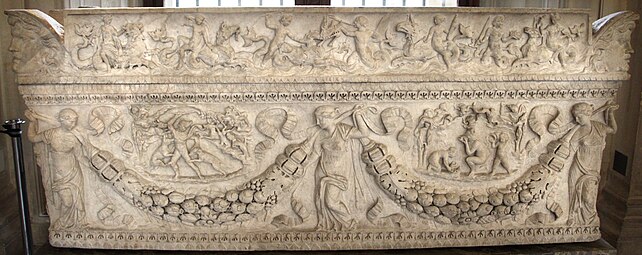
![Roman festoon, c.70 BC, mosaic, Casa di Nettuno e Anfitrite, Herculaneum Archaeological Park, Ercolano, Italy[5]](http://upload.wikimedia.org/wikipedia/commons/thumb/d/d0/Herculaneum_97_%2814896258706%29.jpg/340px-Herculaneum_97_%2814896258706%29.jpg)

![Byzantine festoon at the top of a relief of Empress Ariadne, c.500, ivory, National Bargello Museum, Florence, Italy[6]](http://upload.wikimedia.org/wikipedia/commons/thumb/2/2b/Imp%C3%A9ratrice_Ariane.JPG/130px-Imp%C3%A9ratrice_Ariane.JPG)
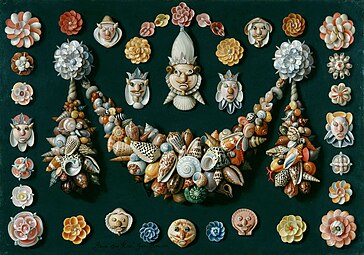

![Baroque festoons on the boiserie of a room from the Hôtel Colbert de Villacerf, now in the Musée Carnavalet, Paris, unknown architect, sculptor and painter, c.1650[7]](http://upload.wikimedia.org/wikipedia/commons/thumb/b/b6/Mus%C3%A9e_Carnavalet_in_Paris_DSC06601_%2851600026401%29.jpg/383px-Mus%C3%A9e_Carnavalet_in_Paris_DSC06601_%2851600026401%29.jpg)
![Baroque festoon with a mascaron in the Hall of Mirrors of the Palace of Versailles, Versailles, France, designed by Jules Hardouin-Mansart, 1678-1684[8]](http://upload.wikimedia.org/wikipedia/commons/thumb/f/fd/Ch%C3%A2teau_de_Versailles%2C_galerie_des_glaces_02.jpg/340px-Ch%C3%A2teau_de_Versailles%2C_galerie_des_glaces_02.jpg)

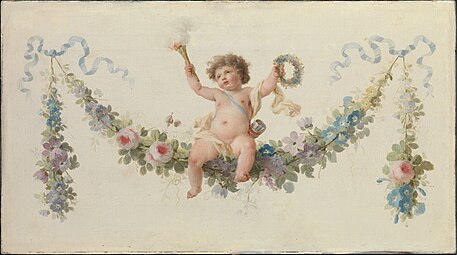
![Louis XVI style festoons on the Table de Teschen, by Johann Christian Neuber, 1775-1800, gilt bronze, semiprecious stones, porcelain, and wood, Louvre[9]](http://upload.wikimedia.org/wikipedia/commons/thumb/9/90/Table_de_Teschen_%28Louvre%2C_OA_12547%29_top.jpg/340px-Table_de_Teschen_%28Louvre%2C_OA_12547%29_top.jpg)

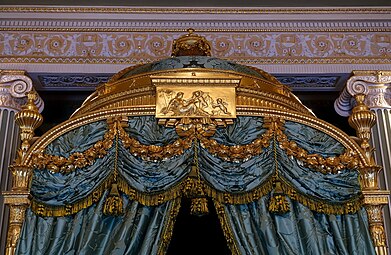

![Louis XVI style festoons on a ceiling in the State Dining Room, Inveraray Castle, Scotland, the UK, by Girard and Guinand, 1784[10]](http://upload.wikimedia.org/wikipedia/commons/thumb/0/0a/INVERARAY_CASTLE_CEILING_DETAIL.JPG/388px-INVERARAY_CASTLE_CEILING_DETAIL.JPG)
![Neoclassical festoon on a vase, by the Sèvres Porcelain Factory, 1814, hard-paste porcelain with platinum background and gilt bronze mounts, Louvre[11]](http://upload.wikimedia.org/wikipedia/commons/thumb/5/5e/Pair_of_Spindle_Vases_-_OA_11090_-_Louvre_%2805%29.jpg/155px-Pair_of_Spindle_Vases_-_OA_11090_-_Louvre_%2805%29.jpg)

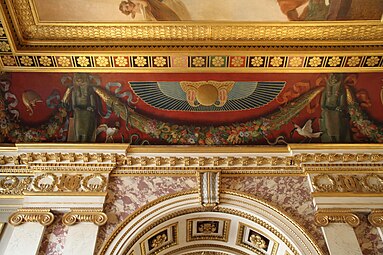
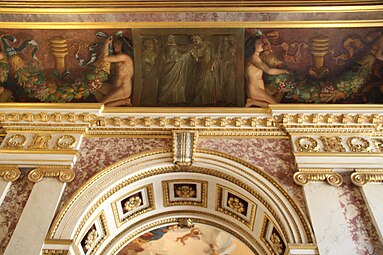
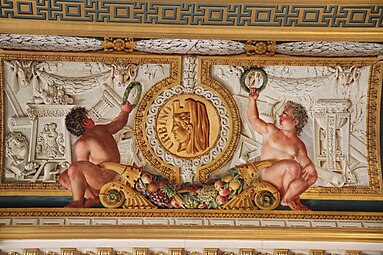
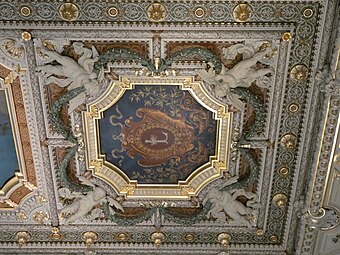
![Neoclassical festoon on the facade of the Palais Garnier, Paris, designed by Charles Garnier, 1860–1875[12]](http://upload.wikimedia.org/wikipedia/commons/thumb/f/f9/D%C3%A9tail_fa%C3%A7ade_principale_Palais_Garnier_Paris_6.jpg/383px-D%C3%A9tail_fa%C3%A7ade_principale_Palais_Garnier_Paris_6.jpg)
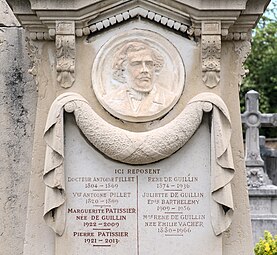
![Neoclassical relief with putti and festoons on the Dimitrie Sturdza House (Strada Arthur Verona no. 13-15), Bucharest, Romania, 1883, unknown architect[13]](http://upload.wikimedia.org/wikipedia/commons/thumb/2/21/13_Strada_Arthur_Verona%2C_Bucharest_%2802%29.jpg/341px-13_Strada_Arthur_Verona%2C_Bucharest_%2802%29.jpg)
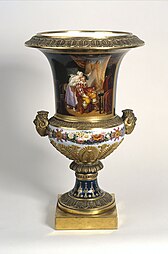

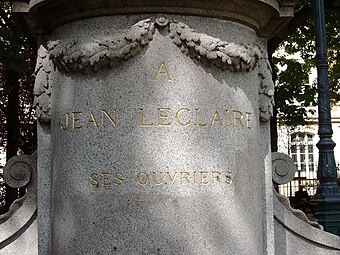


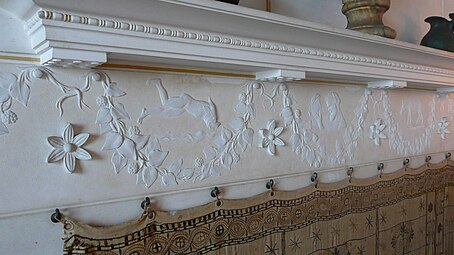

![Beaux Arts festoons above the door of Avenue Kléber no. 47bis, Paris, unknown architect, 1908[14]](http://upload.wikimedia.org/wikipedia/commons/thumb/c/cf/47BIS_Avenue_Kl%C3%A9ber%2C_Paris_%2801%29.jpg/190px-47BIS_Avenue_Kl%C3%A9ber%2C_Paris_%2801%29.jpg)

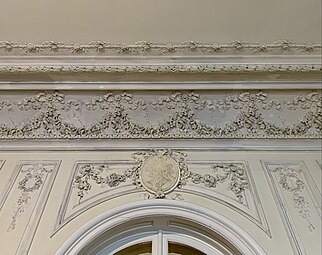
![Beaux Arts swags of a cartouche on the Nicolae T. Filitti/Nae Filitis House (Calea Dorobanților no. 18), by Ernest Doneaud, c.1910[15]](http://upload.wikimedia.org/wikipedia/commons/thumb/6/69/18_Calea_Doroban%C8%9Bilor%2C_Bucharest_%2817%29.jpg/158px-18_Calea_Doroban%C8%9Bilor%2C_Bucharest_%2817%29.jpg)
![Art Nouveau festoons on the walls and columns of a room in the Casa Comalat, Barcelona, Spain, by Salvador Valeri i Pupurull, 1911[16]](http://upload.wikimedia.org/wikipedia/commons/thumb/2/2a/Casa_Comalat_interior_16.jpg/384px-Casa_Comalat_interior_16.jpg)
![Rococo Revival festoon on a stained-glass window in the orangery of the Ecaterina Procopie House (Strada Bocșa no. 4), Bucharest, unknown architect or painter, c.1912[17]](http://upload.wikimedia.org/wikipedia/commons/thumb/0/0a/4_Strada_Boc%C8%99a%2C_Bucharest_%2810%29.jpg/186px-4_Strada_Boc%C8%99a%2C_Bucharest_%2810%29.jpg)



